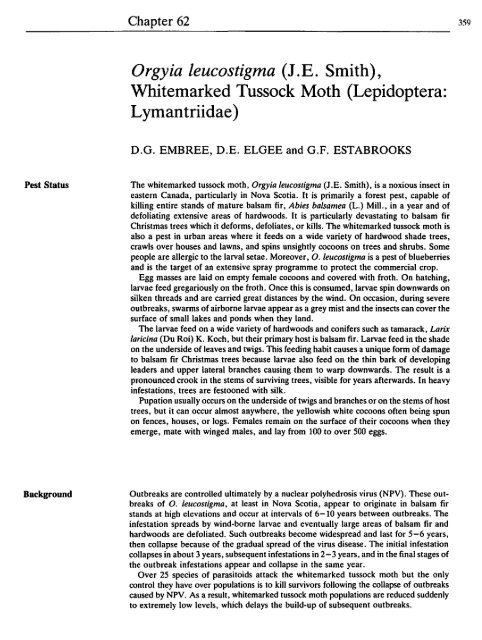pdf, 57.71Mb - Entomological Society of Canada
pdf, 57.71Mb - Entomological Society of Canada
pdf, 57.71Mb - Entomological Society of Canada
Create successful ePaper yourself
Turn your PDF publications into a flip-book with our unique Google optimized e-Paper software.
Pest Status<br />
Background<br />
Chapter 62<br />
Orgyia leucostigma (J.E. Smith),<br />
Whitemarked Tussock Moth (Lepidoptera:<br />
Lymantriidae)<br />
D.G. EMBREE, D.E. ELGEE and G.F. ESTABROOKS<br />
The whitemarked tussock moth, Orgyia leucostigma (J.E. Smith), is a noxious insect in<br />
eastern <strong>Canada</strong>, particularly in Nova Scotia. It is primarily a forest pest, capable <strong>of</strong><br />
killing entire stands <strong>of</strong> mature balsam fir, Abies balsamea (L.) Mill., in a year and <strong>of</strong><br />
defoliating extensive areas <strong>of</strong> hardwoods. It is particularly devastating to balsam fir<br />
Christmas trees which it deforms, defoliates, or kills. The white marked tussock moth is<br />
also a pest in urban areas where it feeds on a wide variety <strong>of</strong> hardwood shade trees,<br />
crawls over houses and lawns, and spins unsightly cocoons on trees and shrubs. Some<br />
people are allergic to the larval setae. Moreover, O. leucostigma is a pest <strong>of</strong> blueberries<br />
and is the target <strong>of</strong> an extensive spray programme to protect the commercial crop.<br />
Egg masses are laid on empty female cocoons and covered with froth. On hatching,<br />
larvae feed gregariously on the froth. Once this is consumed, larvae spin downwards on<br />
silken threads and are carried great distances by the wind. On occasion, during severe<br />
outbreaks, swarms <strong>of</strong> airborne larvae appear as a grey mist and the insects can cover the<br />
surface <strong>of</strong> small lakes and ponds when they land.<br />
The larvae feed on a wide variety <strong>of</strong> hardwoods and conifers such as tamarack, Larix<br />
laricina (Du Roi) K. Koch, but their primary host is balsam fir. Larvae feed in the shade<br />
on the underside <strong>of</strong> leaves and twigs. This feeding habit causes a unique form <strong>of</strong> damage<br />
to balsam fir Christmas trees because larvae also feed on the thin bark <strong>of</strong> developing<br />
leaders and upper lateral branches causing them to warp downwards. The result is a<br />
pronounced crook in the stems <strong>of</strong> surviving trees, visible for years afterwards. In heavy<br />
infestations, trees are festooned with silk.<br />
Pupation usually occurs on the underside <strong>of</strong> twigs and branches or on the stems <strong>of</strong> host<br />
trees, but it can occur almost anywhere, the yellowish white cocoons <strong>of</strong>ten being spun<br />
on fences, houses, or logs. Females remain on the surface <strong>of</strong> their cocoons when they<br />
emerge, mate with winged males, and lay from 100 to over 500 eggs.<br />
Outbreaks are controlled ultimately by a nuclear polyhedrosis virus (NPV). These outbreaks<br />
<strong>of</strong> O. leucostigma, at least in Nova Scotia, appear to originate in balsam fir<br />
stands at high elevations and occur at intervals <strong>of</strong> 6-10 years between outbreaks. The<br />
infestation spreads by wind-borne larvae and eventually large areas <strong>of</strong> balsam fir and<br />
hardwoods are defoliated. Such outbreaks become widespread and last for 5-6 years,<br />
then collapse because <strong>of</strong> the gradual spread <strong>of</strong> the virus disease. The initial infestation<br />
collapses in about 3 years, subsequent infestations in 2-3 years, and in the final stages <strong>of</strong><br />
the outbreak infestations appear and collapse in the same year.<br />
Over 25 species <strong>of</strong> parasitoids attack the whitemarked tussock moth but the only<br />
control they have over populations is to kill survivors following the collapse <strong>of</strong> outbreaks<br />
caused by NPV. As a result, whitemarked tussock moth populations are reduced suddenly<br />
to extremely low levels, which delays the build-up <strong>of</strong> subsequent outbreaks.<br />
359
















